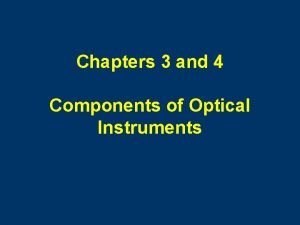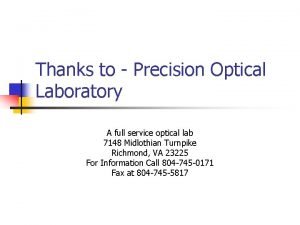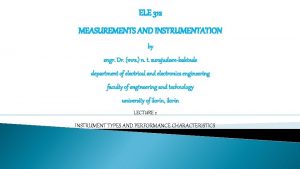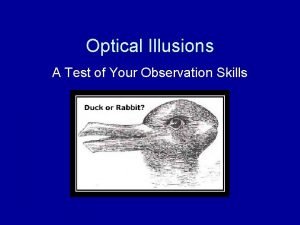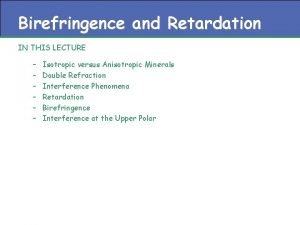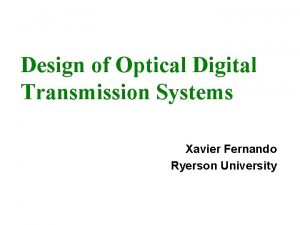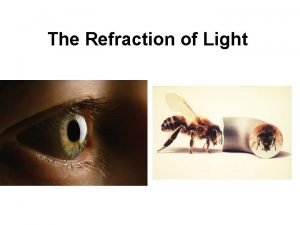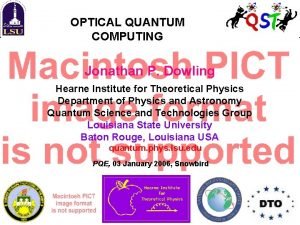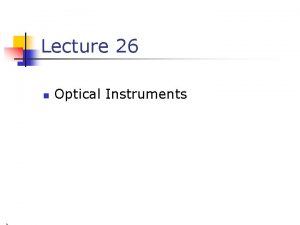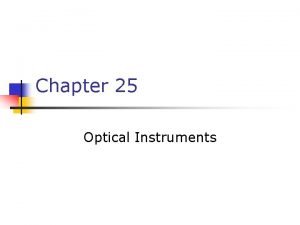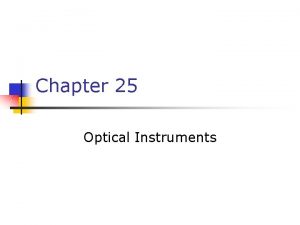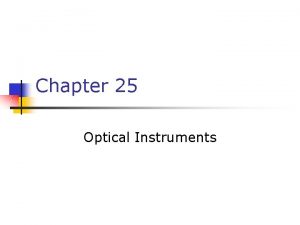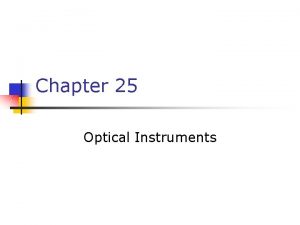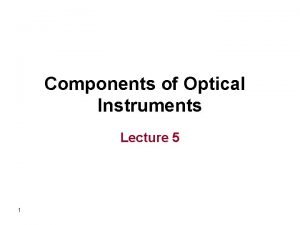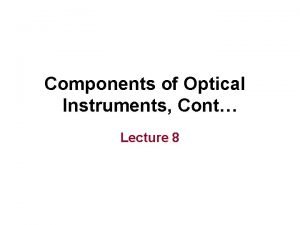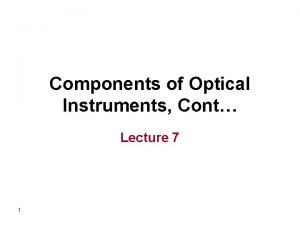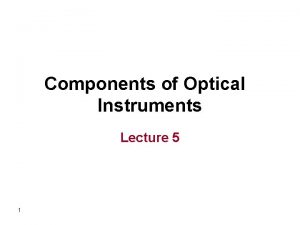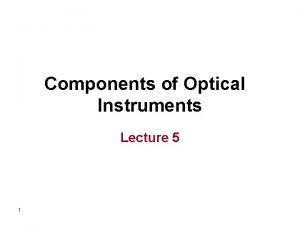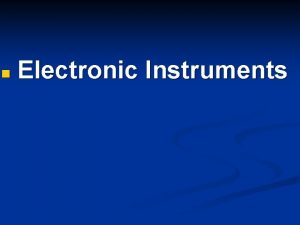Components of Optical Instruments Lecture 9 1 4




















- Slides: 20

Components of Optical Instruments Lecture 9 1

4. Silicon Diode Transducers A semiconductor material like silicon can be doped by an element of group V (like arsenic and antimony) would have more electrons as a group V atom (5 e) replaces a silicon atom (4 e). The thus doped semiconductor is called an n-type semiconductor. In contrast, when a group III element (3 e) is doped in a silicon matrix, replacement of a silicon atom (4 e) with a group III atom (like indium or gallium, 3 e) results in the formation of a less electrons semiconductor or a p-type. 2

A diode is a device that has a greater conductance in one direction than the other. A diode is manufactured by forming adjacent n-type and p-type regions within the same silicon or germanium single crystal. The term pn junction refers to the interface between these two regions. A diode can be connected to a power supply (a battery) in one of two modes: 3

4

A silicon diode transducer consists of a reverse-biased pn junction formed on a silicon crystal. The application of a reverse bias creates a depletion layer that will ultimately result in zero current. When a beam of radiation hits silicon diode, holes and electrons will be formed in the depletion layer thus producing a current proportional to the intensity of incident radiation. Silicon diodes are more sensitive than phototubes but far less sensitive than photomultiplier tubes. They can be used in both UV and visible regions 5

5. Multichannel Photon Transducers The simplest multichannel transducer ever made is the photographic film where the full image can be captured in one shot. However, the time required for handling and developing the film makes it difficult to practically use it in conventional instruments, although it is still in use in some techniques like x-ray diffraction spectroscopy. There are two other major classes of multichannel photon transducers, which find important applications and use in spectroscopic instruments. 6

a. Photodiode arrays (PDA) These are simply linear arrays of silicon diodes described above. The number of linear diodes used in each photodiode array usually 64 to 4096 with 1024 silicon diodes as the most common. One can imagine the complexity of the electronic circuitry used in such an array as well as the data handling and manipulation requirements. The entrance slit is usually fixed at a size enough to fill the surface area of one silicon diode. The entire spectrum can thus be instantaneously recorded. The arrays are also called diode array detectors (DAD). 7

8

9

b. Charge Transfer and Charge Coupled Transducers The photosensitive elements are, in contrary to PDAs, arranged in two dimensions in both charge injection devices (CID) and chargecoupled devices (CCD). Therefore, these are very similar to photographic films. For example, a commercially available transducer is formed from 244 rows with each row containing 388 detector elements. This will add up to a two-dimensional array holding 16672 detector elements (pixels) on silicon chip that is 6. 5 mm by 8. 7 mm. 10

11

Introduction to Atomic Spectroscopy 12

Technique – Flame Test 13

An Introduction to Optical Atomic Spectroscopy In optical atomic spectrometry, compounds are first converted to gaseous molecules followed by conversion to gaseous atoms. This process is called atomization and is a prerequisite for performing atomic spectroscopy. Gaseous atoms then absorb energy from a beam of radiation or simply heat. Absorbance can be measured or emission from excited atoms is measured and is related to concentration of analyte. 14

Atomic Energy Level Diagrams As a start, we should be aware that only valence electrons are responsible for atomic spectra observed in a process of absorption or emission of radiation in the UV-Vis region. Valence electrons in their ground states are assumed to have an energy equal to zero e. V. As an electron is excited to a higher energy level, it will absorb energy exactly equal to the energy difference between the two states. Let us look at a portion of the sodium energy level diagram where sodium got one electron in the 3 s orbital: 15

16

The dark lines represent most probable transitions and in an atomic spectrum they would appear more intense than others. It should also be indicated that two transitions, of very comparable energies (589. 0 and 589. 6 nm), from the 3 s ground state to 3 p excited state do take place. This suggests splitting of the p orbital into two levels that slightly differ in energy. Explanation of this splitting may be presented as a result of electron spin where the electron spin is either in the direction of the orbital motion or opposed to it. 17

Both spin and orbital motion create magnetic fields that may interact in an attractive manner (if motion is in opposite direction, lower energy), or in a repulsive manner when both spin and orbital motion are in the same direction (higher energy). The same occurs for both d and f orbitals but the energy difference is so small to be observed. A Mg+ ion would show very similar atomic spectrum as Na since both have one electron in the 3 s orbital. 18

In cases where atoms of large numbers of electrons are studied, atomic spectra become too complicated and difficult to interpret. This is mainly due to presence of a large numbers of closely spaced energy levels It should also be indicated that transition from ground state to excited state is not arbitrary and unlimited. Transitions follow certain selection rules that make a specific transition allowed or forbidden. 19

Each type of atoms would have certain preferred or most probable transitions (sodium has the 589. 0 and the 589. 6 nm). Relaxation would result in very intense lines for these preferred transitions where these lines are called resonance lines. Absorption of energy is most probable for the resonance lines of each element. Thus intense absorption lines for sodium will be observed at 589. 0 and 589. 6 nm. 20
 Components of optical instruments
Components of optical instruments Components of optical instruments
Components of optical instruments Optical amplifiers lecture notes
Optical amplifiers lecture notes Precision optical lab
Precision optical lab 01:640:244 lecture notes - lecture 15: plat, idah, farad
01:640:244 lecture notes - lecture 15: plat, idah, farad Passive instruments
Passive instruments Pressure measuring devices
Pressure measuring devices Optical interconnect solutions
Optical interconnect solutions How to draw input devices
How to draw input devices Optical transimpedance amplifier
Optical transimpedance amplifier Disadvantages of profile projector
Disadvantages of profile projector Disadvantages of current transformer
Disadvantages of current transformer Optical computing examples
Optical computing examples Optical fiber waveguides
Optical fiber waveguides Picture observation test
Picture observation test Birefringence and retardation
Birefringence and retardation Optical imaging
Optical imaging Coherent detection in optical communication
Coherent detection in optical communication Rainbow total internal reflection
Rainbow total internal reflection Dowling optical
Dowling optical Doric vs ionic
Doric vs ionic

